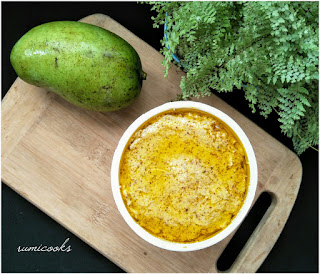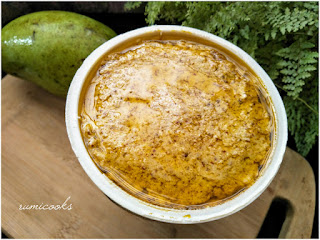Kasundi is a traditional Bengali recipe which is a variety of mustard sauce. It is generally a pungent paste of mustard seeds and mango which is also known as aam kasundi. It is a sour, sweet and hot sauce which can be served as a dip or as a side dish with rice or roti.
After making mango pickle twice for this season, I had some raw mangoes left in my refrigerator. So I decided to make aam kasundi today. I didn't make this mustard sauce in the traditional Bengali method. Bengalis kept the sauce in earthen pot for 7 days before consuming and they use raw mustard oil. I made this kasundi to serve instantly after making. Actually I don't have an earthen pot to keep my kasundi sauce and so I adopted this method.
My 7 year old daughter was so curiously observing me while I was making the sauce. She asked me "what are you making momma?" I said " you'll not like it dear, it's taste is so pungent" But she insisted to taste it. And after she tasted, she said "it's hot".
Aam Kasundi / Mango and Mustard Sauce
📎Course : Dip/Side.
📎Cuisine : Indian/Bengali
📎Cuisine : Indian/Bengali
🔪Preparation Time : 20 minutes
♨Cooking Time : 2 minutes
🕞Total : 22 minutes
INGREDIENTS:
INGREDIENTS:
- 5-6 garlic cloves
- 4-5 green chilies
- 1/4 cup yellow mustard seeds
- 1 tbsp black mustard seeds
- 1 big raw mango
- 1/2 cup mustard oil (or as required)
- 2 tbsp vinegar
- 1 tbsp salt
- 1 tbsp sugar
METHOD:
- Peel the garlic cloves and wash under running water. Wash green chillies under running water.
- wash yellow mustard seeds and black mustard seeds under running water and let it dry under sun for 3-4 hours, together with garlic cloves and green chillies.
- Peel and wash raw mango. Now cut in small pieces and put it under sun to dry for 3- 4 hours.
- Now in a blender jar take yellow mustard seeds, black mustard seeds, garlic cloves, green chillies, raw mango pieces, salt, and sugar. Add vinegar and blend into a fine paste.
- In a pan heat mustard oil. Off the burner and pour everything from the blender and mix well in the mustard oil.
- Let it cool and transfer it in an airtight container.
- Keep it in the refrigerator.




Comments
Post a Comment